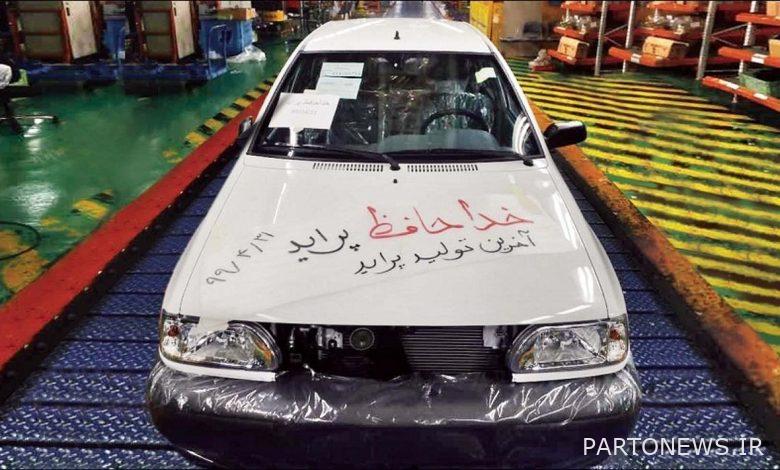Where did Pride reach 300 million? / What was the story of Hashemi Rafsanjani’s Pride Ride?

According to the online economy report, quoted by Ferraro, the president of Iran in those days behind a pride Nasim Meshki sits down and spins with it. Now 28 years have passed since that day and Aliakbar Hashemi Rafsanjani is no longer with us, but Pride is there and recently we have seen many headlines about its price reaching 300 million. A number which, of course, is related to the few models produced in 2018 and 2019, and now that two years have passed since Stop production of Pride It passes, not the correct basis for the price of Pride. However, if we review the previous 28 years, different versions of Pride have been launched in the market, except for the Nasim version which was introduced and unveiled in the presence of the president according to the procedure of domestic car production.
Pride entered the market for the first time in 1973 in the form of Nasim and Saba models. Nasim models were the same as hatchbacks and Saba models were considered the cashier’s pride, and they were considered stylish and modern options in an era when there was not much variety for buyers. At that time, the price of Pride was set at two million Tomans by SAIPA, and this number was estimated to be equivalent to 12 thousand dollars, including the exchange rate of those days. Official statistics show that the minimum wage approved by the labor law in 1972 was 108,000 tomans a year, and the price of Pride was equal to 18 months’ salary.
The production of Pride Saba and Nasim continued from 1973 to the end of the 80s, and in these years their prices increased by 285 and 340 percent. Because in 2009, when Saipa decided to introduce Pride 131 and 111 instead of these two, the price of Saba Pride was seven million and 700 thousand tomans and Pride Nasim was sold at eight million and 800 thousand tomans. Of course, between the years when Pride Saba and Nasim gave their place to Pride 131 and 111, there was another model of Pride called Pride Sefari or station version in the market, which of course could never experience good sales like other versions. The production of Pride Safari was launched in 1978 and many people said that because it has more space, it will be well received in the market. However, Pride was considered a failure for Saipa and was discontinued in the mid-80s.
Pride 141 was considered one of the first facelifts of the Saba model and it was supposed to diversify Saipa’s product portfolio. The new design of the trunk was considered the most important of the new version of Pride Cashier, although many market experts consider Pride 141 not a sedan but a liftback, but in fact, the addition of hydraulic steering, anti-lock brakes, and front airbags are considered the most important changes of this version. they were going Pride 141 in 1982, that is, the same years it was introduced to the market, was worth approximately 6 million 500 thousand Tomans, and in 1993, when Saipa restricted its production, it was worth 14 million 980 thousand Tomans in the factory and 17 million and 17 million in the open market. 600 thousand tomans were exchanged.
Pride 132 was introduced almost at the same time as the departure of Pride Safari from the production line, and it was considered the newest version of this family in the mid-80s. Pride 132 was originally a facelift of Pride Saba or Pride cashier, and its most important appearance differences compared to Pride Saba were the change in the shape of the trunk, fenders, rear lights, the addition of hydraulic steering and such things, otherwise, like Pride 141, It was sold with the same old Pride engine. On the other hand, changing the shape of the rear trunk made the place of the license plate move from the trunk to the bumper, and all these created a new appearance for Pride 132. Pride 132 was sold in 2006 for around seven million tomans. In 2018, when Pride 132 was scheduled to be released, its price in the factory was 28 million 700 thousand Tomans and in the market was about 43 million Tomans. That is, within 12 years, the price of Pride 132 at the factory had experienced a 310% jump.
Pride 131 and 111 were the new version of Saba and Nasim, respectively. 131 and 111 were introduced to the market at the same time as Saipa said goodbye to Pride Saba and Nasim, which were sold with options such as hydraulic steering, ABS brakes, and driver’s airbag. The new design of the dashboard, the addition of the three-digit numbers 131 and 111 to the trunk, the new form of the lights were also considered the changes in the appearance of these two models. Pride 131 and 111 in the first days when they were on the market, their price was about eight to eight million and 500 thousand tomans, and in 99 when their production was stopped forever, their price in the factory was 37 million and 380 thousand tomans and 42 million and 100 thousand respectively. It was Toman.
That year, there was a bigger gap between the factory price and the market, and these two models were traded for around 70 million tomans. Now, zero-kilometer models that have not been sold since 2018 and 2019 are being sold on car buying and selling platforms at a price of 300 million tomans. At the beginning of the article, we talked about equating the price of Pride with 18 months of salary in 1972, and now that the few zero-kilometer Pride models are advertised around 300 million tomans, the price of Pride is equivalent to 53 months of a worker’s salary instead of 18 months.

